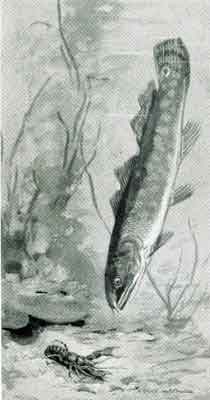The American Bowfin - A Living Fossil
By H. REVELL WHITRIDGE
Nature Magazine, September 1937
In the summer of 1929, Lake Leelanau, situated in Leelanau County, Michigan, was a body of water new to me. However, I was reasonably sure that there, were no species of fish in the lake that I had not caught elsewhere, except the bowfin, Amia calva. So I decided to concentrate my efforts on this species, and learn all I could about its habits and fighting qualities at first hand.
For the first two days I was unsuccessful; and then by chance I saw one where and when I least expected it. On the deep edge of the boathouse, in three feet of water, I had placed a minnow trap baited with oatmeal cooked into a firm mass. I often sat in the end of the boat and looked down at the minnows and small game fish attracted by this bait. Few of us escape the lure of watery depths, whether they be the blue of the salt ocean, or the murky shallows of a pond. The imagination of the Nature lover is awakened by the possibility of what may be below the surface. As a boy, I was always fascinated by the sight of tadpoles, small fishes, or the occasional view of a water snake or turtle in a pond.
This day 1 had been observing quietly the life around the trap, and in and about the weed bed. I had counted six species of small game fish, a water snake, and two turtles, along with countless minnows. None displayed fear of the others, but all were quite conscious, evidently, of the taste of oatmeal. Suddenly there appeared a head from the weeds on the very bottom-a sinister head, almost perfect in its camouflage of olive green. The head was the size of a man's fist. The eyes stared coldly. Despite the size of the head, I doubt whether my eyes would have distinguished it among the weeds had I not seen it edge into view.

THE BOWFIN IS CARNIVOROUS
For almost a minute the evil-looking eyes surveyed the life about the trap. Then the head withdrew as though it had dissolved before my eyes. I could compare the whole experience to nothing except my imagination of an elephant peering from the edge of a forest at a group of small children dancing around a Maypole.
If the small fish had observed the monster, surely they had paid no attention to him, for I did not see one quick darting movement such as characterizes fright in these little fellows. I am uncertain as to whether they did not see him, or were without fear, confident of escape in the weeds and shallow water.
The catching of the first bowfin happened the next day at noon. I was using a five-inch common shiner for bait. Fishing in about twelve feet of water, I had scarcely played out ten feet of line when I had a strike vicious enough to have been caused by a four-pound small-mouth black bass. I had several minutes of excellent sport before I landed the prize. The fish weighed nine and a quarter pounds, and was thirty-two inches long. The head was bluntish, and larger by far than my fist. The body, oblong and robust, was covered with large scales, and the general color was dark olive, almost black above, shading down to a light olive green on the sides, and fading to almost a pinkish yellow or sand color on the belly. The mouth was large, slightly oblique, and lined with sharp teeth.
Few people catching a bowfin are apt to prize it until they are aware of its uniqueness. This quality lies in the fact that it is the only surviving species of the entire family to which it belongs, the family Amiidae. Other species of this family that were living millions of years ago are represented now only by fossils. In Europe the indigenous bowfin evidently became extinct at the end of the Lower Miocene period, but in North America our bowfin still survives.
 Printer-friendly version
Printer-friendly version
